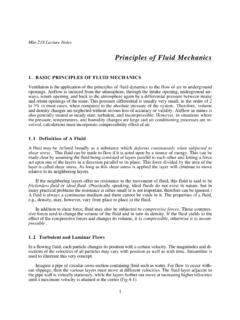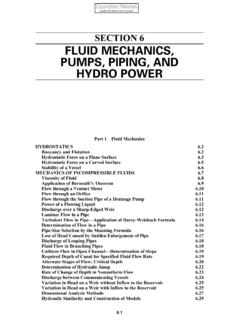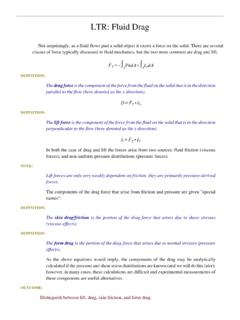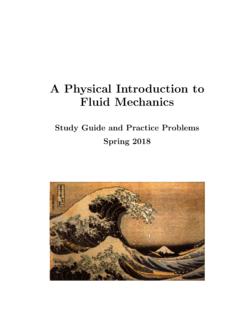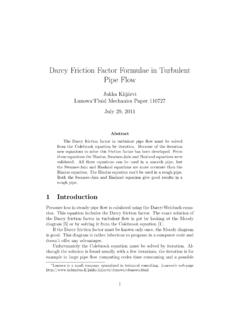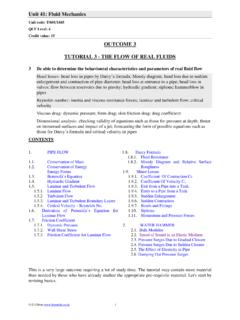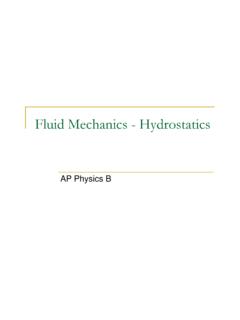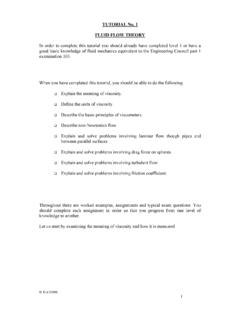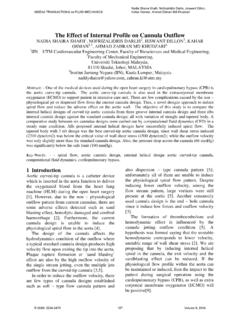Transcription of FLUID MECHANICS TUTORIAL No.7 FLUID FORCES
1 1 FLUID MECHANICS TUTORIAL FLUID FORCES When you have completed this TUTORIAL you should be able to Solve FORCES due to pressure difference. Solve problems due to momentum changes. Solve problems involving pressure and momentum changes. Solve FORCES on pipe bends. Solve problems on stationary vanes. Construct blade vector diagrams for moving vanes. Calculate the momentum changes over a moving vane. Let's start by examining FORCES due to pressure changes. 1. PRESSURE FORCES Consider a duct as shown in First identify the control volume on which to conduct a force balance.
2 The inner passage is filled with FLUID with pressure p1 at inlet and p2 at outlet. There will be FORCES on the outer surface of the volume due to atmospheric pressure. If the pressures of the FLUID are measured relative to atmosphere ( use gauge pressures) then these FORCES need not be calculated and the resultant force on the volume is due to that of the FLUID only. The approach to be used here is to find the FORCES in both the x and y directions and then combine them to find the resultant force. Fig. 1 The force normal to the plane of the bore is pA. At the inlet (1) the force is Fp1= p1A1 At the outlet (2) the force is Fp2 = p2A2 These FORCES must be resolved vertically and horizontally to give the following.
3 Fpx1 = Fp1 cos 1 (to the right) Fpx2 = Fp1 cos 2 (to the left) The total horizontal force FH = Fpx1 - Fpx2 Fpy1 = Fp1 sin 1 (up) Fpy2 = Fp2 sin 2 (down) The total vertical force FV = Fpy1 - Fpy2 2 WORKED EXAMPLE No. 1 A nozzle has an inlet area of m2 and it discharges into the atmosphere. The inlet gauge pressure is 3 bar. Calculate the resultant force on the nozzle. SOLUTION Since the areas are only in the vertical plane, there is no vertical force. FV = 0 Using gauge pressures, the pressure force at exit is zero.
4 Fpx2 = 0 Fpx1 = 3 x 105 x = 1500 N FH = 1500 0 = 1500 N to the right. WORKED EXAMPLE The nozzle shown has an inlet area of m2 and an outlet area of m2. The inlet gauge pressure is 300 kPa and the outlet gauge pressure is 200 kPa. Calculate the horizontal and vertical FORCES on the nozzle. SOLUTION Fp1= 300 x 103 x = 600 N Fpx1= 600 N Fpy1=0 N since the plane is vertical. Fp2 = 200 x 103 x = 100 N Fpx2 = 100 x cos 60o = 50 N Fpy2 = 100 x sin 60o = N Total Horizontal force FH = 600 - 50 = 550 N Total vertical force FV = 0 - N = - N 3 2.
5 MOMENTUM FORCES When a FLUID speeds up or slows down, inertial FORCES come into play. Such FORCES may be produced by either a change in the magnitude or the direction of the velocity since either change in this vector quantity produces acceleration. For this section, we will ignore pressure FORCES and just study the FORCES due to velocity changes. NEWTON'S 2nd LAW OF MOTION This states that the change in momentum of a mass is equal to the impulse given to it. Impulse = Force x time Momentum = mass x velocity Change in momentum = mv Newton s second law may be written as mv = Ft Rearrange to make F the subject.
6 Mv/t = F Since v/t = acceleration a we get the usual form of the law F = ma The mass flow rate is m/t and at any given moment this is dm/dt or m' and for a constant flow rate, only the velocity changes. In fluids we usually express the second law in the following form. F = (m/t) v = m' v m' v is the rate of change of momentum so the second law may be restated as F = Rate of change of momentum F is the impulsive force resulting from the change. v is a vector quantity. APPLICATION TO PIPE BENDS Consider a pipe bend as before and use the idea of a control volume. 4 First find the vector change in velocity using trigonometry.
7 ()(){}2121222122vcos vsin v v vcos vsin vtan += = Alternatively v could be found by drawing the diagram to scale and measuring it. If we had no change in magnitude then v1 = v2 = v then v= v {2(1 - cos )} The momentum force acting on the FLUID is Fm = m' v The force is a vector quantity which must be in the direction of v. Every force has an equal and opposite reaction so there must be a force on the bend equal and opposite to the force on the FLUID . This force could be resolved vertically and horizontally such that FH = Fmcos and FV = Fmsin This theory may be applied to turbines and pump blade theory as well as to pipe bends.
8 SELF ASSESSMENT EXERCISE 1. A pipe bends through an angle of 90o in the vertical plane. At the inlet it has a cross sectional area of m2 and a gauge pressure of 500 kPa. At exit it has an area of m2 and a gauge pressure of 200 kPa. Calculate the vertical and horizontal FORCES due to the pressure only. (Answers 200 N and 1500 N). 2. A pipe bends through an angle of 45o in the vertical plane. At the inlet it has a cross sectional area of m2 and a gauge pressure of 800 kPa. At exit it has an area of m2 and a gauge pressure of 300 kPa. Calculate the vertical and horizontal FORCES due to the pressure only.
9 (Answers N and 1430 N). 3. Calculate the momentum force acting on a bend of 130o that carries 2 kg/s of water at 16m/s velocity. Determine the vertical and horizontal components. (Answers N and N) 4. Calculate the momentum force on a 180o bend that carries 5 kg/s of water. The pipe is 50 mm bore diameter throughout. The density is 1000 kg/m3. (Answer N) 5. A horizontal pipe bend reduces from 300 mm bore diameter at inlet to 150 mm diameter at outlet. The bend is swept through 50o from its initial direction. The flow rate is m3/s and the density is 1000 kg/m3. Calculate the momentum force on the bend and resolve it into two perpendicular directions relative to the initial direction.
10 (Answers N and N). 5 3. COMBINED PRESSURE AND MOMENTUM FORCES Now we will look at problems involving FORCES due to pressure changes and momentum changes at the same time. This is best done with a worked example since we have covered the theory already. WORKED EXAMPLE A pipe bend has a cross sectional area of m2 at inlet and m2 at outlet. It bends 90o from its initial direction. The velocity is 4 m/s at inlet with a pressure of 100 kPa gauge. The density is 1000 kg/m3. Calculate the FORCES acting parallel and perpendicular to the initial direction.










